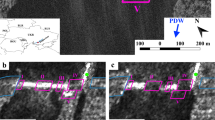Abstract
The small martian satellites Phobos and Deimos orbit in synchronous rotation with inclinations of only 0.01° and 0.92°, respectively, relative to the planet's equatorial plane. Thus, an observer at near-equatorial latitudes on Mars could occasionally observe solar eclipses by these satellites (see ref. 1, for example). Because the apparent angular diameter of the satellites is much smaller than that of the Sun, however, such events are more appropriately referred to as transits. Transit data can be used for correcting and refining the orbital ephemerides of the moons. For example, Phobos is known to exhibit a secular acceleration that is caused by tidal dissipation within Mars2,3,4. Long-term, accurate measurements are needed to refine the magnitude and origin of this dissipation within the martian interior as well as to refine the predicted orbital evolution of both satellites5,6. Here we present observations of six transits of Phobos and Deimos across the solar disk from cameras on Mars aboard the Mars Exploration Rovers Spirit and Opportunity7,8. These are the first direct imaging observations of satellites transiting the Sun from the surface of another planet.
This is a preview of subscription content, access via your institution
Access options
Subscribe to this journal
Receive 51 print issues and online access
$199.00 per year
only $3.90 per issue
Buy this article
- Purchase on Springer Link
- Instant access to full article PDF
Prices may be subject to local taxes which are calculated during checkout


Similar content being viewed by others
References
Ledger, E. The eclipses of the satellites of Mars. The Observatory 3, 191–193 (1879)
Smith, J. C. & Born, G. H. Secular acceleration of Phobos and Q of Mars. Icarus 27, 51–53 (1976)
Born, G. H. & Duxbury, T. C. The motions of Phobos and Deimos from Mariner 9 TV data. Celest. Mech. 12, 77–88 (1975)
Bills, B. G. et al. Improved estimate of tidal dissipation within Mars from MOLA observations of the shadow of Phobos. J. Geophys. Res. (in the press)
Sinclair, A. T. The orbits of the satellites of Mars determined from Earth-based and spacecraft observations. Astron. Astrophys. 220, 321–328 (1989)
Mignard, F. Evolution of the Martian satellites. Mon. Not. R. Astron. Soc. 194, 365–379 (1981)
Squyres, S. W. et al. The Athena Mars Rover Science Investigation. J. Geophys. Res. 108, 8062, doi:10.1029/2003JE002121 (2003)
Bell, J. F. III et al. The Mars Exploration Rover Athena Panoramic Camera (Pancam) Investigation. J. Geophys. Res. 108, 8063, doi:10.1029/2003JE002070 (2003)
Viking Lander Imaging Team. The Martian Landscape NASA SP-425 (US Government Printing Office, Washington, DC, 1978)
Bills, B. G. & Comstock, R. Solar eclipses on Mars: Spatial and temporal patterns in the motion of the shadow of Phobos. Eos Trans. AGU 84 (Fall Meeting Suppl.), abstr. G41B–30 (2003).
Duxbury, T. C. Phobos transit of Mars as viewed by the Viking cameras. Science 199, 1201–1202 (1978)
Betts, B. H., Murray, B. C. & Svitek, T. Thermal inertias in the upper millimeters of the Martian surface derived using Phobos' shadow. J. Geophys. Res. 100, 5285–5296 (1995)
Neumann, G. A., Bills, B. G., Smith, D. E. & Zuber, M. T. Refinement of Phobos ephemeris using Mars Orbiter Laser Altimeter radiometry. Lunar Planet. Sci. Conf. XXXV abstr. 1820 (2004)
Arvidson, R. E. et al. Localization and physical properties experiments conducted by Spirit at Gusev crater. Science 305, 821–824 (2004)
Arvidson, R. E. et al. Localization and physical properties experiments conducted by Opportunity at Meridiani Planum. Science 306, 1730–1733 (2004)
Jacobson, R. A., Synnott, S. P. & Campbell, J. K. The orbits of the satellites of Mars from spacecraft and earthbased observations. Astron. Astrophys. 225, 548–554 (1989)
Acknowledgements
These observations were made possible by the hard work of the engineers and scientists working with the Mars Exploration Rovers Spirit and Opportunity. We thank D. Limonadi, S. Spohn and J. Swift for their assistance with MER clock drift corrections. We also thank B. Bills for critical comments that improved this paper. This research is supported by grants and contracts from the NASA Mars Exploration Rover project.
Author information
Authors and Affiliations
Corresponding author
Ethics declarations
Competing interests
Reprints and permissions information is available at npg.nature.com/reprintsandpermissions. The authors declare no competing financial interests.
Rights and permissions
About this article
Cite this article
Bell, J., Lemmon, M., Duxbury, T. et al. Solar eclipses of Phobos and Deimos observed from the surface of Mars. Nature 436, 55–57 (2005). https://doi.org/10.1038/nature03437
Received:
Accepted:
Issue Date:
DOI: https://doi.org/10.1038/nature03437
This article is cited by
-
The Mars 2020 Perseverance Rover Mast Camera Zoom (Mastcam-Z) Multispectral, Stereoscopic Imaging Investigation
Space Science Reviews (2021)
-
GETEMME—a mission to explore the Martian satellites and the fundamentals of solar system physics
Experimental Astronomy (2012)
-
Twin studies on Mars
Nature (2005)
Comments
By submitting a comment you agree to abide by our Terms and Community Guidelines. If you find something abusive or that does not comply with our terms or guidelines please flag it as inappropriate.



